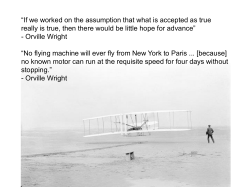
A Utility-Based Routing Scheme in MANETs
FluidRating: A Time-Evolving Rating
Scheme in Trust-based Recommendation
Systems Using Fluid Dynamics
Wenjun Jianga,b, Prof. Jie Wub,
Prof. Guojun Wanga and Huanyang Zhengb
a
Central South University
bTemple University
Outline
1. Trust-based Recommendation
2. Motivation
3. Problem
4. Solution: FluidRating
5. Experimental Evaluation
6. Conclusion & Future Work
Personalized Recommendation
Too many choices in daily life:
which restaurant for dinner,
which movie to watch,
which product to purchase....
Personalized recommendation
1. Trust-based Recommendation
Two types of information
user to user: web of trust
user to item: review, rating
Basic idea
use the knowledge of a trust network among users,
to provide personalized recommendations by
aggregating the opinions of their trusted friends
2. Motivation
Consider time-evolving effects
users receive different influences at different
times
upon receiving an influence, users’ reactions can vary
Differentiate direct and indirect influences
Capture user features
key feature we are considering: persistency
how much one insists on his or her opinion
High quality personalized recommendation
2. Motivation
Existing trust-based recommendation methods
calculate at the current time
take direct friends, and friends of friends, equally
assume adoption of all influences
In real life
time-evolving system
closer friends have more opportunities for influence
upon receiving influence, different users may take
different actions (depending on user features)
Problem
System setting: Rating network
Nodes
raters
R
R {a1, a2 }
non-raters N {a , a , a }
3 4 5
sink
S {a6 }
a1 3
0.8
a3
0.7
0.7 a5
0.6
Influence relations
0.8
a4
0.7
converted from trust relations
from raters to sink
from raters to non-raters, then to sink
0.7
0.5
0.5
a2 5
S
N
0.6
a6
Problem
Time-evolving rating prediction
Tasks
predict rating efficiently
reflect time-evolving effect
capture user features
Solution
Time-evolving opinion formulation process
each user receives the influence
updates his own opinion
propagates his opinion to other friends
Discretized view
each user exchanges his opinions with those of his
neighbors
Model the process using fluid dynamics theory
Solution
Social principles
Principle 1: First Influence Dominates.
Principle 2: Stronger Influence Dominates.
Physical principles
Principle 3: Mass Conservation.
Principle 4: Energy Conservation.
Solution
FluidRating: three components
container
container: user
pipe: influence relation
fluid: recommendation
temperature as rating
height
fluid
pipe
height as persistency
Influence: two micro steps
compare persistency (fluid height)
fluid flowing from one container to another
Solution
FluidRating
from rating network to fluid dynamics system
R
a1 3
0.8
a3
0.7
0.7 a5
0.6
0.8
0.7
a6
0.5
0.5
a2 5
S
N
0.6
a1
a2
3℃
5℃
a3
a4
a5
a6
h
a4
0.7
rating network
fluid dynamics system
a0
Solution
FluidRating: 3 steps
Fluid Updating Preparation
Calculate the fluid volume that will flow (each pair of users)
Fluid Updating Execution
Let fluid flow and mix (all users)
Sample Aggregation
collect and aggregate samples (from multiple rounds)
Solution
Step 1: Fluid Updating Preparation
the speed of efflux: Torricelli’s law
vaa' 2 g (ha ha ' )
the volume of fluid that will flow
saa' 2 g[ha (i ) ha ' (i )] waa'
the temperature of fluid that will flow
taa' ta
waa’
a
a’
Solution
Step 2: Fluid Updating Execution
the updated volume
s
sa (i 1) sa (i )
aa'
a 'N ao u t
Incoming
a '' a
a ''N ain
Outgoing
wa’’a
a’’
s
waa’
a’
a
the updated temperature
ta (i ) [ sa (i )
ta (i 1)
s
aa'
]
a 'N ao u t
sa (i 1)
t
a '' a
a ''N ain
sa ''a
Solution
Step 2: Fluid Updating Execution
example
Time slot
k=0
Containers
a1
a2
a3
a4
a5
a6
a0
Pipes
k=1
a1
a2
a3
a4
a5
a6
a0
a1
a2
a3
a4
a5
a6
a0
...
k=16
Pipes
k=17
a1
a2
a3
a4
a5
a6
a0
Solution
Step 3: sample aggregation
aggregation sequence can be uniform or non-uniform
give earlier samples more weight
k
tan q1c ( i 1) tan (i )
i 1
Convergence of Example Scenario
The height and temperature become stable after some time
The varition decreases with iterations
Experimental Evaluation
Data set: Epinions
Test method: Leave-one-out
Metric: RMSE
RMSE
2
ˆ
(
r
r
)
u,i u,i / D
Experimental Evaluation
The effects of first influence
(a) and (b) show four different patterns of 4 user/item test pairs.
In all the four patterns, the first samples give predictions close
to the real truth.
(c) provides a comparison of the average ratings with respect to
the number of iterations (i.e., k) and the maximum length
Experimental Evaluation
The effects of impact factors
The left figure depicts the average predicted rating with FluidRating 1,
and different settings of the time slot duration.
The right figure shows the RMSE of FluidRating 1 with c=1, and q
changing from 0.1 to 0.9.
Experimental Evaluation
The effects of aggregation methods
This figure compares FluidRating 1 with c = 0, c = 1, and q = 0.5;
the latter is denoted as FluidRating 1*.
Finding: When we put more weight on the earlier influence,
the accuracy is improved.
Experimental Evaluation
Comparison of Multiple Methods
The comparison of several trust-based recommendation methods
Finding: FluidRating beats others; the RMSE of using FluidRating 1* is
4.812% less than that of using TidalTrust when the maximum length=6
Summary of Experiments
Validate the time-evolving effects
Validate the existence of first influence
Test the effects of several factors
iteration number
time duration
aggregation sequence
sample approach (see details in paper)
Conclusion & Future Work
Conclusion
FluidRating can reflect the time-evolving feature
differentiate direct and indirect influence
reflect the user personality feature (persistency)
Future work
More personality features (e.g., persuasiveness)
Real experience evolution
Thank you for your attention
Wenjun Jiang
wenjj8a@gmail.com
Jie Wu
jiewu@temple.edu
© Copyright 2025









